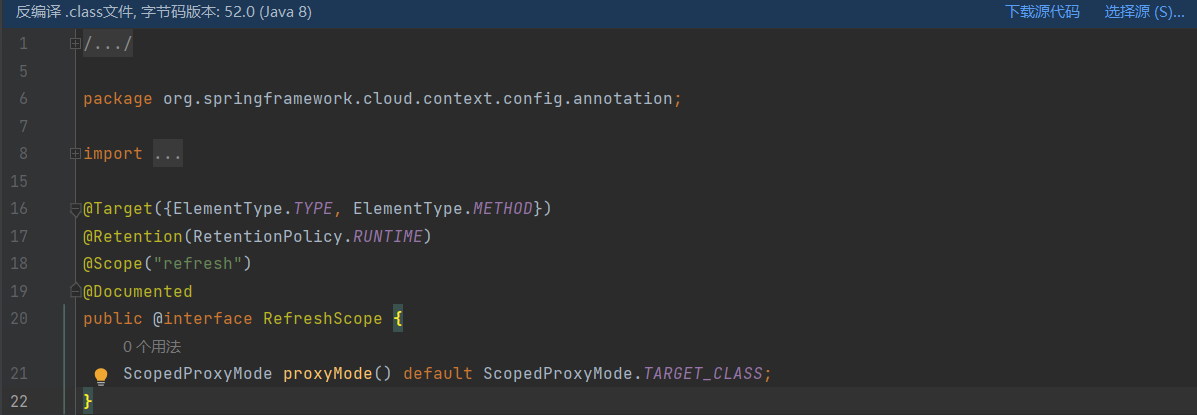一、@RefreshScope注解是什么?
@RefreshScope是Spring Cloud提供的一个特殊作用域注解,它允许应用程序在运行时动态刷新被注解的Bean及其依赖项,而无需重启应用。这个功能在需要频繁修改配置的微服务架构中尤为重要,是Spring Cloud Config实现配置热更新的核心技术。
核心特性
-
动态刷新:修改配置后,相关Bean自动重新初始化
-
细粒度控制:可针对特定Bean进行刷新
-
零停机:无需重启应用即可应用新配置
-
与Spring Cloud Config无缝集成:配合配置服务器使用效果最佳
-
作用域扩展:基于标准Spring的
@Scope机制扩展实现
二、@RefreshScope的实现原理
1. 底层机制
@RefreshScope本质上是Spring标准@Scope注解的一个特殊实现,其核心原理如下:
-
代理模式:创建被注解Bean的代理对象
-
缓存机制:维护配置值的缓存版本
-
刷新触发:当收到刷新事件时清除缓存
-
懒加载:实际使用时才会获取最新配置
2. 技术组件
-
Scope接口实现:
RefreshScope类实现org.springframework.beans.factory.config.Scope接口 -
Bean生命周期管理:通过
GenericScope处理Bean的创建和销毁 -
上下文事件监听:监听
RefreshEvent来触发刷新
3. 工作流程
-
应用启动时,被
@RefreshScope注解的Bean被特殊处理 -
Spring创建这些Bean的代理对象而非实际实例
-
首次访问时,代理对象从环境(Environment)读取配置并创建真实Bean
-
当配置变更触发
/actuator/refresh端点时:-
清除所有
@RefreshScopeBean的缓存 -
销毁现有实例
-
-
下次访问这些Bean时,重新初始化并加载新配置
三、@RefreshScope的使用方法
1. 基本使用
添加依赖(Spring Boot 2.4+):
<dependency>
<groupId>org.springframework.cloud</groupId>
<artifactId>spring-cloud-starter</artifactId>
</dependency>
注解Bean:
@Service
@RefreshScope
public class MyService {
@Value("${app.config.property}")
private String configProperty;
// Getter方法
}
2. 与@ConfigurationProperties结合使用
@RefreshScope
@ConfigurationProperties(prefix = "app")
public class AppConfig {
private String name;
private int version;
// 标准的getter和setter
}
3. 在Controller中使用
@RestController
@RefreshScope
public class ConfigController {
@Value("${message:Hello default}")
private String message;
@GetMapping("/message")
public String getMessage() {
return this.message;
}
}
四、触发配置刷新的方式
1. 手动刷新(生产环境慎用)
发送POST请求:
curl -X POST http://localhost:8080/actuator/refresh
响应示例:
[
"app.config.property"
]
2. 自动刷新(与Spring Cloud Bus集成)
添加依赖:
<dependency>
<groupId>org.springframework.cloud</groupId>
<artifactId>spring-cloud-starter-bus-amqp</artifactId>
</dependency>
配置RabbitMQ后,修改配置仓库会通过消息队列自动通知所有服务刷新。
3. Webhook自动刷新(Git仓库)
在Git仓库配置Webhook,指向Config Server的/actuator/bus-refresh端点。
五、@RefreshScope的注意事项
1. 使用限制
-
不适用于所有Bean:特别是那些保持状态的单例Bean
-
启动时验证:初始配置仍需有效,刷新只影响运行时
-
性能考虑:频繁刷新可能影响性能
2. 常见问题解决方案
问题1:刷新后Bean未更新
-
检查是否真的调用了refresh端点
-
确认配置属性确实发生了变化
-
检查Bean是否真的被
@RefreshScope注解
问题2:循环依赖问题
-
避免
@RefreshScopeBean之间的循环依赖 -
考虑使用
@Lazy注解打破循环
问题3:静态字段不更新
-
@RefreshScope不适用于静态字段 -
解决方案:通过非静态方法访问配置
六、@RefreshScope的高级用法
1. 条件性刷新
@RefreshScope
public class ConditionalRefreshBean {
@Value("${app.feature.enabled:false}")
private boolean featureEnabled;
// 只有当featureEnabled为true时才执行刷新逻辑
@Scheduled(fixedRate = 5000)
public void checkRefresh() {
if(featureEnabled) {
// 执行需要刷新的操作
}
}
}
2. 自定义刷新策略
实现RefreshEventListener接口:
@Component
public class CustomRefreshListener implements ApplicationListener<RefreshEvent> {
@Override
public void onApplicationEvent(RefreshEvent event) {
// 自定义刷新逻辑
System.out.println("自定义刷新处理...");
}
}
3. 部分属性刷新
@RefreshScope
public class PartialRefreshBean {
// 只有这些特定属性变化时才刷新
@Value("${app.important.config}")
private String importantConfig;
// 这个属性变化不会触发刷新
@Value("${app.secondary.config}")
private String secondaryConfig;
}
七、@RefreshScope与其他Spring技术的整合
1. 与Spring Cloud Config整合
典型架构:
-
配置存储在Git/SVN/数据库
-
Config Server集中管理配置
-
客户端使用
@RefreshScope监听变化
客户端配置:
spring:
application:
name: my-service
cloud:
config:
uri: http://config-server:8888
fail-fast: true
2. 与Spring Boot Actuator整合
暴露refresh端点:
management:
endpoints:
web:
exposure:
include: refresh,health,info
3. 与Spring Cloud Bus整合
实现配置变化的批量通知:
spring:
rabbitmq:
host: rabbitmq
port: 5672
username: guest
password: guest
八、@RefreshScope的性能优化
1. 刷新范围控制
-
只对真正需要动态更新的Bean使用
@RefreshScope -
避免在频繁访问的Bean上使用,减少代理开销
2. 批量刷新策略
-
设置合理的刷新间隔,避免过于频繁
-
考虑使用
@Scheduled定时批量处理刷新
3. 缓存优化
@RefreshScope
@Service
public class CachedService {
private final LoadingCache<String, String> cache;
public CachedService() {
this.cache = Caffeine.newBuilder()
.maximumSize(100)
.build(key -> expensiveOperation(key));
}
// 刷新时清空缓存
@EventListener
public void onRefresh(RefreshEvent event) {
cache.invalidateAll();
}
}
九、实际应用案例
案例1:动态日志级别调整
@RefreshScope
@Configuration
public class LoggingConfig {
@Value("${logging.level.root:INFO}")
private String rootLevel;
@PostConstruct
public void init() {
LoggerContext loggerContext = (LoggerContext) LoggerFactory.getILoggerFactory();
loggerContext.getLogger("ROOT").setLevel(Level.valueOf(rootLevel));
}
}
案例2:功能开关动态切换
@RefreshScope
@Service
public class FeatureService {
@Value("${features.new.checkout:false}")
private boolean newCheckoutEnabled;
public boolean isNewCheckoutEnabled() {
return newCheckoutEnabled;
}
}
案例3:多环境配置动态加载
@RefreshScope
@RestController
@RequestMapping("/api")
public class ApiController {
@Value("${api.endpoint}")
private String apiEndpoint;
@GetMapping
public ResponseEntity<?> callApi() {
// 使用当前配置的endpoint
return restTemplate.getForEntity(apiEndpoint, String.class);
}
}
十、常见问题解答
Q1:@RefreshScope和@ConfigurationProperties哪个更好?
-
@RefreshScope:更灵活,可应用于任何Bean -
@ConfigurationProperties:更结构化,适合集中管理相关属性 -
最佳实践:两者可以结合使用
Q2:为什么刷新后我的Bean状态没有改变?
-
可能原因:未正确调用refresh端点;属性名不匹配;Bean未被代理
-
解决方案:检查refresh响应;确认属性源;调试Bean类型
Q3:生产环境使用@RefreshScope有什么风险?
-
风险点:并发问题;性能影响;配置不一致
-
缓解措施:充分测试;限制刷新频率;监控刷新结果
十一、总结与最佳实践
1. 核心价值总结
@RefreshScope为Spring应用提供了:
-
配置热更新的标准化方案
-
微服务架构下的灵活配置能力
-
提升系统可用性的重要手段
2. 使用建议
-
适度使用:只对需要动态更新的Bean应用
-
明确范围:清楚了解哪些属性会被刷新
-
监控刷新:记录刷新事件和结果
-
异常处理:考虑刷新失败的回退方案
3. 未来展望
随着云原生技术的发展,@RefreshScope可能会:
-
与Kubernetes ConfigMap更深度集成
-
支持更细粒度的属性级刷新
-
提供更完善的刷新事务支持
@RefreshScope作为Spring Cloud配置动态化的核心技术,正确理解和使用它能够显著提升微服务系统的灵活性和可维护性,是现代Spring开发者必备的重要技能之一。






















 939
939

 被折叠的 条评论
为什么被折叠?
被折叠的 条评论
为什么被折叠?










